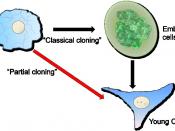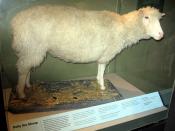Cloning
With the technology the Earth possesses, cloning has become one of them. To clone is to create or propagate an organism from a clone cell. People have always wondered what is would be like to have something cloned. Thinking if it is a good or bad thing to do. Scientists have done research and have experimented with cloning. Whether or not to clone humans is still a mystery.
Dolly a Finn Dorset sheep was the first cloned animal. She was born on June 5, 1996 and died 6 years after. She died due to progressive lung disease. In her years of life she gave birth to 4 lambs. Professor Wilmut says, "The fact that we were able to produce an animal from the cell of another adult - it had profound effects on biological research and in medicine." He thinks that with this we are able to clone other animals to enable people to have plenty of food to eat.
In her years of life she gave birth to 4 lambs.
Dr Harry Griffin, from the institute, said: "Sheep can live to 11 or 12 years of age and lung infections are common in older sheep, particularly those housed inside." This shows that Dolly died halfway through her life with a case that should occur when she is older. Professor Richard Gardner, chair of the Royal Society working group on stem cell research and therapeutic cloning, said: "We must await the results of the post-mortem on Dolly in order to assess whether her relatively premature death was in any way connected with the fact that she was a clone.
Now researchers are checking to see if the cloning had any connection with Dolly's premature death. If there is not, in the future there might be cloning of humans.


